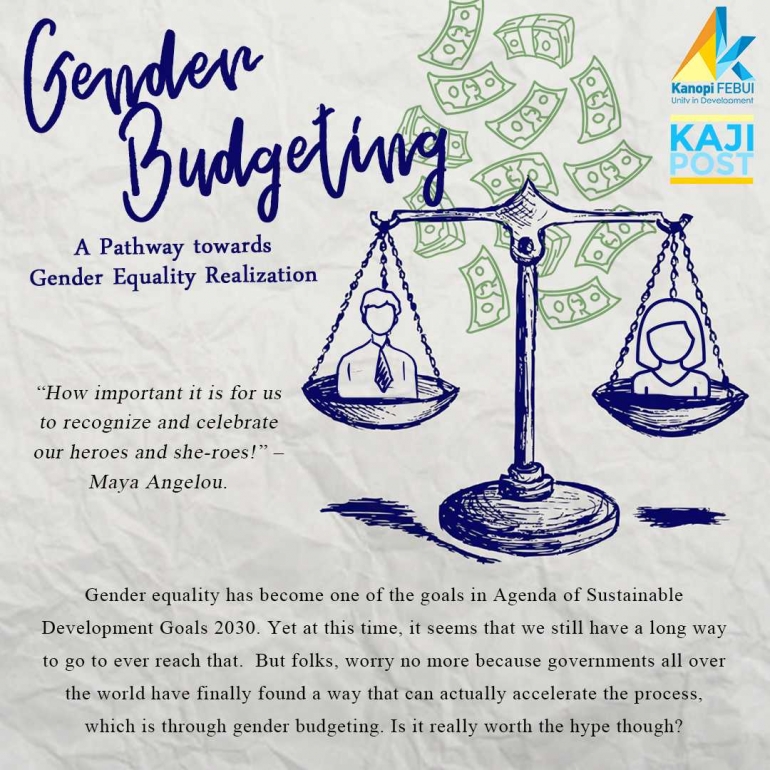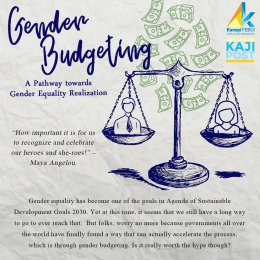When I was a delegate for a Model United Nations (MUN) competition this August, I got a chance to bring up the issue of women's economic empowerment in the changing world of work. Acting as a representative of one's country, the other delegates and I were being asked to craft a resolution to achieve the empowerment of women all over the world in economic aspects.
One key component of the resolution is the creation of funding mechanisms to support all the solutions that we had proposed. As we all may know, budgeting process tends to be connected with men's political domination.
There has never been any classification of policy that takes into consideration on how it may affect women in general, most policies only talk about whether it will help the poor and the marginalized or not, but never in terms of gender. Through gender budgeting, it can actually correct the pre-existing flaws.
In regards of funding mechanism that I included in my resolution was about gender budgeting, which is a gender based assessment of budgets incorporating a gender perspective at all levels of the budgetary process and restructuring revenues and expenditures in order to promote gender equality.
Also, Chakraborty in 2014 inferred that gender budgeting is an approach to fiscal policies and administration that translates gender-related commitments into fiscal commitments through identified processes, resources, and institutional mechanisms, impacting both the spending and revenue sides of the budget.
Many countries, especially the ones that are part of the OECD, have implemented this kind of budget assessment and the governments of those countries said that the implementation of this has successfully made a much better difference in terms of ensuring gender equality at all levels in one nation.
We are all aware that in order for us to achieve the agenda of Sustainable Development Goals 2030, the world needs to realize 17 goals in which two of those goals are related to gender issues, which are gender equality and reduced inequalities. Gender budgeting, in trying to uphold the principles of gender equality in the policymaking process, may assist directly in the achievement of those goals.
You Can Count on Me
Since its first introduction by the Australian Government in 1984, gender budgeting has always been acclaimed to be an effective toolkit in applying a gender perspective in the policymaking process. The process that has been incorporated in gender budgeting allows government to better understand how revenue and spending, as well as the policies guiding the budget may affect women and men differently.
It also doesn't stop within the sphere of what kind of policies do the government make that will actually affect the gender mainstreaming process, but also to the extent of ensuring the equal opportunity for both women and men to participate in the policy-making process, especially regarding the incorporation of gender perspective into various policies.
In India for example, they have implemented the four phases of gender budgeting which include knowledge building and networking, institutionalizing, capacity building, and enhancing accountability.
These phases have resulted in several successful outcomes in realizing gender equality, such as in terms of enhancing accountability, the Government of India has published a Report on Gender Budgeting in the State Finance Account that can show the actual money spent on women in nation's policies.
There are definitely no way to know how gender budgeting can be used best, but governments usually pull the levers through two major aspects of their fiscal scope, which are tax measures and direct expenditures.
Tax measures can be used in aiming which taxed area needs to be looked-into further and the direct expenditures will assess the need to consider the allocation of budgeting towards welfare, social protection program, and so on. Gender budgeting mainly has two kinds of assessment that are widely practiced: ex ante assessment and ex post assessment.
While ex ante assessment focuses more on the planning side that identifies gender-related needs in various policies, ex post assessment focuses more on the auditing or the measure of achievement to determine if gender equality is already effectively promoted or attained through the policies.
Ex ante assessment considers several actions that need to be done to ensure the policies that the government made is gender sensitive, which consist of making a gender budget baseline analysis, undertaking gender needs assessments across different policy areas, and also conducting impact assessment of proposed policies toward gender equality.
Sweden, as one of the countries that are already implementing ex ante assessment, believes that gender equality perspective and analysis have to be included in their Budget Bill and they have already established mechanism on how to conduct gender equality analysis in their budgeting process.
The mechanism that is being implemented in Sweden from the analysis of gender equality relevance to the survey execution and ends with impact assessment that will determine whether alternative solutions will be needed or not.
From this mechanism, the government of Sweden has made some reforms regarding some of their policies with one of them being the reform made for sa Regnr's areas, which will include the commitment of the government to form gender equality agency in 2018 and present new national strategy to combat men's violence against women.
For theex post assessment phase or the 'after-implementation' phase, it will typically be conducted to measure whether the implemented policies have reached their intended outcomes, especially regarding their aim to realize gender equality.
The mechanism included contains budget auditing and spending review that incorporate gender perspective in their process. Gender budget auditing and spending review will measure and analyze to what extent gender equality has been attained through various policies set out in the annual budget as well as will be in charge to determine if implemented policies are already effective and efficient in mentioning and delivering gender objectives.
Through this robust mechanism, governments will be able to find possible loopholes as well as identify ways to improve existing gender-related policies.
Economic Impact of Gender Budgeting
Besides the societal benefits that we can get from gender budgeting initiative, we also can't forget the economic benefit this initiative can generate. Some of the good impacts that are being generated from this tool in economic aspect are an increase in GDP and higher level of employment and productivity. To note these benefits, let's take an example of the implementation of gender budgeting in European Union scope to prove whether it is economically beneficial.
According to the European Institute for Gender Equality, compared to the growth effect made by education and labor-related policies, policies that uphold gender equality will increase nation's GDP per capita by 9.6% in 2050.
In addition to this good news, improvements made by gender equality will also boost employment by creating an additional 10.5 million jobs in 2050 which can affect directly the employment rate to reach 80 percentage points.
On the international trade area, improved gender equality will bolster EU's economic competitiveness by increasing an estimated 0.7% of export and decreasing import by 1.2% that will actually lead to a more balanced international trade condition in EU.
From the same studies, overall gender equality-based policies will be much more likely to create better development environment towards the whole economy rather than any other policies, at least in EU states, because statistically, countries in EU that have comparatively more room to improve gender equality will gain an increase of 12% of GDP on average by 2050. Two of those best-performing countries are said to be Belgium and Italy.
Are We There Yet?
It has been proven by the aforementioned examples that in the future, gender budgeting will give positive impacts for social and economic aspects because it can pretty much realize a more inclusive development. In addition, we also have to measure whether the implementation of this tool can actually reduce gender inequality effectively since we know that in some countries other than the EU, especially the developing ones, the focus on gender equality is comparatively lower.
In this case, to see the degree of success in gender budgeting, we need to see it from the impact that can be generated from gender budgeting in achieving equality, growth, inclusive development, and human rights, rather than only because of the implementation that can mere show whether governments have followed the steps of gender budgeting or not ((e.g. Nakray 2009; Mushi and Edward 2010).
Considering the matter above, gender budgeting will be most effective when it involves changes to both policy-making process -- including budget allocations and administrative systems -- monitoring mechanisms (Stotsky 2016a).
In reality, it's still considered as a struggle for countries to find the one effective method of incorporating gender responsive budgeting to their circular budgeting process because most of them still don't have sufficient mechanism in terms of monitoring the outcome of this initiative. Let's take an example from the Government of India where they actually have allocated their national budget towards women's empowerment programs, such as entrepreneurship loan and health program.
We can see that from this scheme, India has taken steps forward to boost gender equality through its fiscal policy but there are still no mention whatsoever about the monitoring and evaluation mechanism that can track the whole allocated budget.
This lack of certain mechanism can be vital since without the monitoring process, the budgetary exercise will definitely remain 'gray', especially for women, because we don't have proper knowledge on the impact of the those policies toward concerned areas.
Judging by the way it's planned, the gender budgeting process itself is already on the edge of success but seeing from the degree of robustness, this gender budgeting that's implemented in most countries are still in dire need of improvement.
All in all, we can still hope that this gender responsive budgeting will actually (and definitely) give some powerful pushes toward the progress in achieving gender equality and inclusive development for all.
But, governments have to take into account the whole part of robust mechanism that starts from the very first planning to the extent of evaluation mechanism completely. We also have to put more efforts in institutionalizing the gender budgeting initiative firmly within the government at all levels to formalize and acquaint the use of it so its implementation can be in accordance with the outcome that we desire.
By: Sendy Jasmine K. Hadi | Ilmu Ekonomi 2017 | Staff Kajian Kanopi FEB UI 2018
Baca konten-konten menarik Kompasiana langsung dari smartphone kamu. Follow channel WhatsApp Kompasiana sekarang di sini: https://whatsapp.com/channel/0029VaYjYaL4Spk7WflFYJ2H








